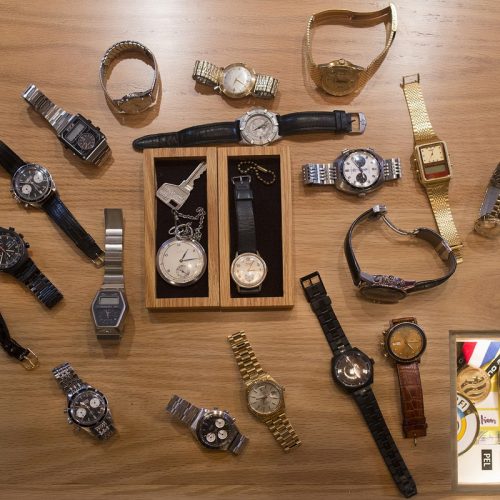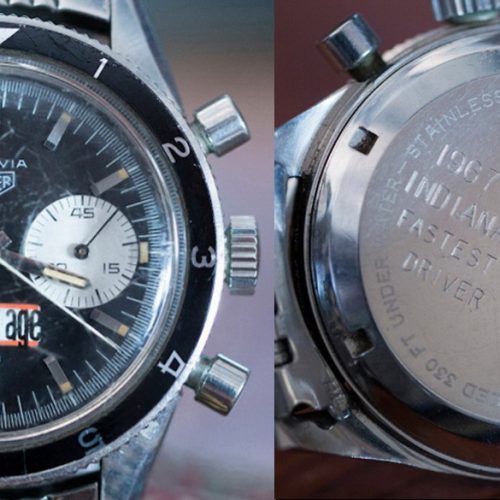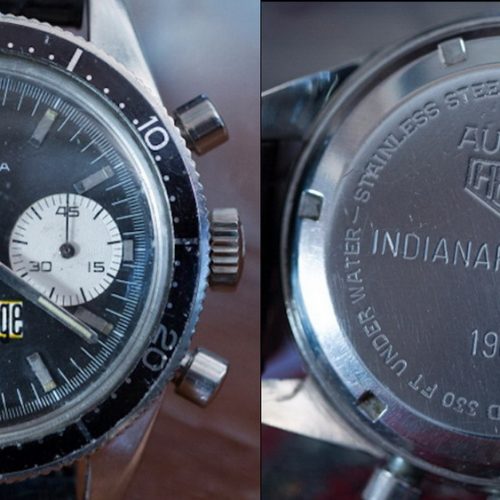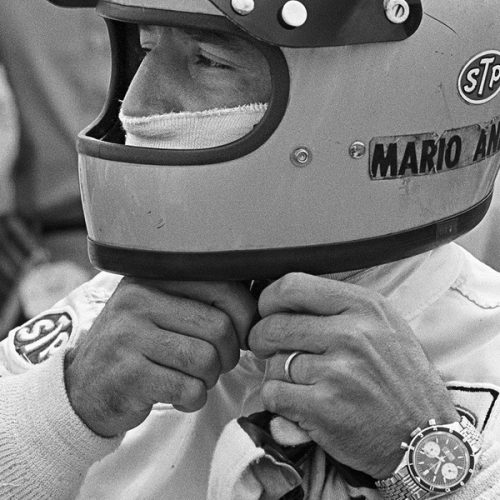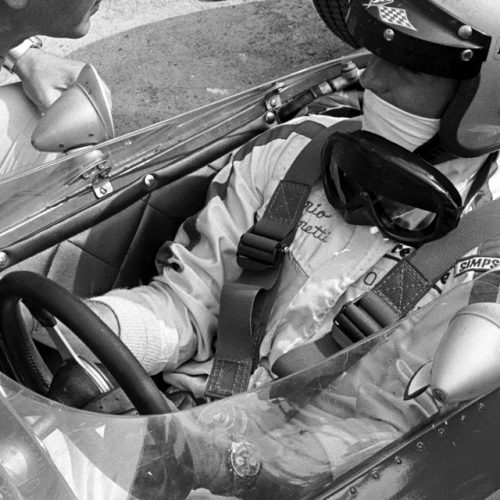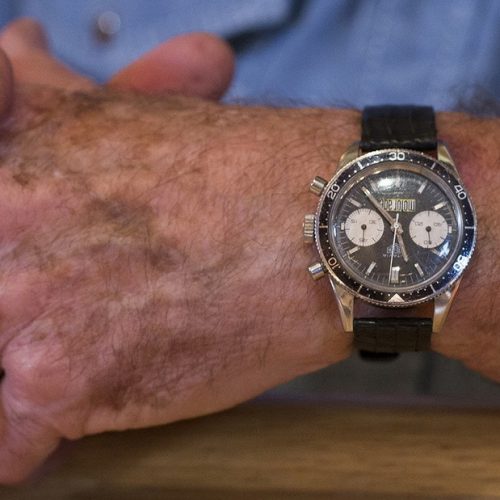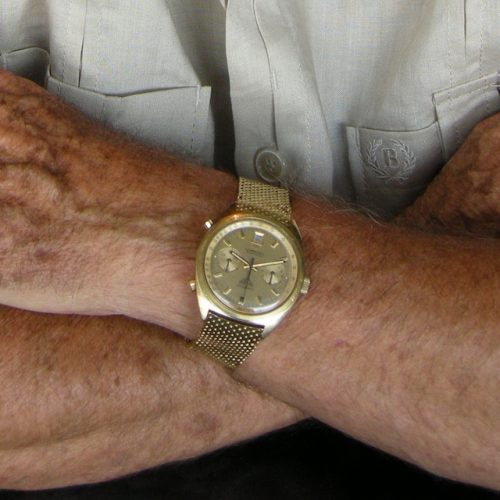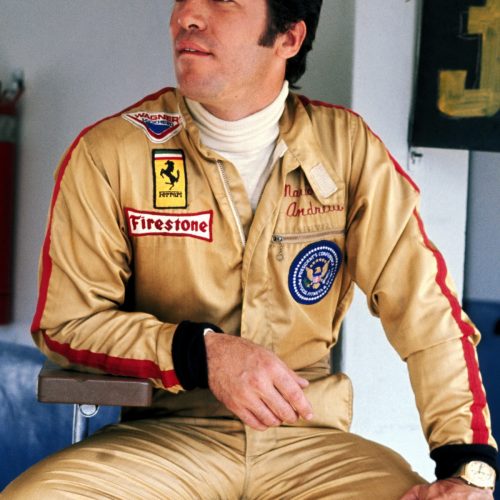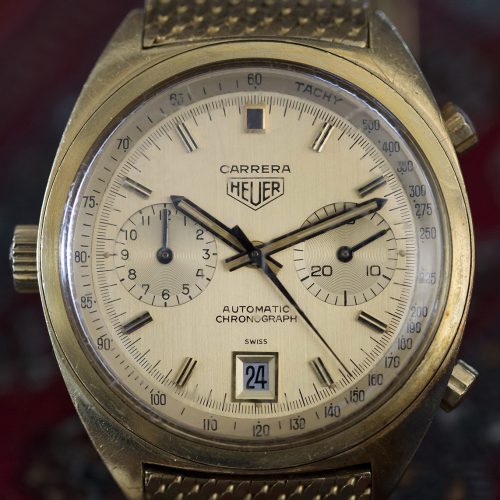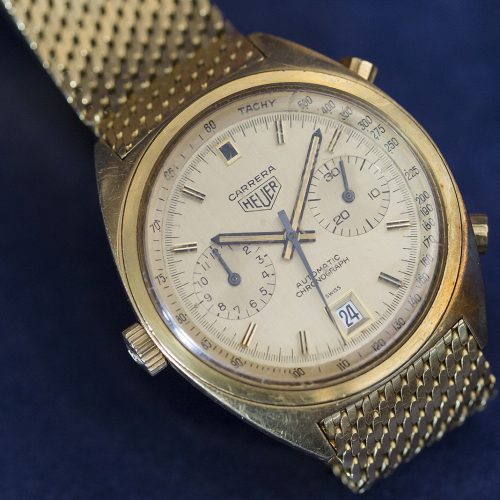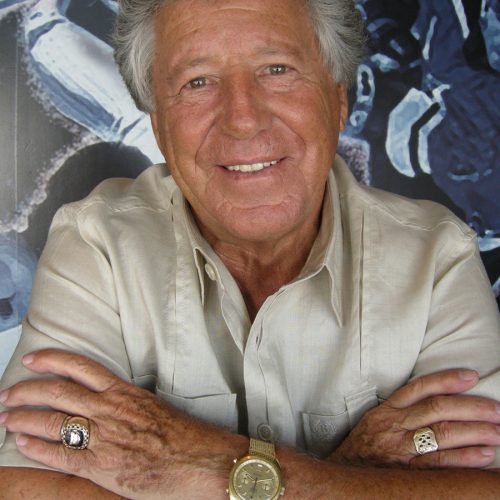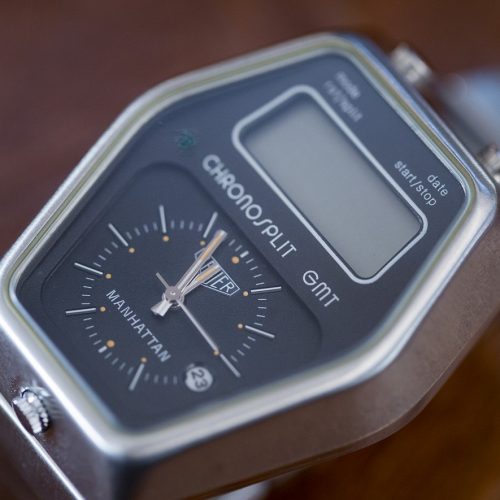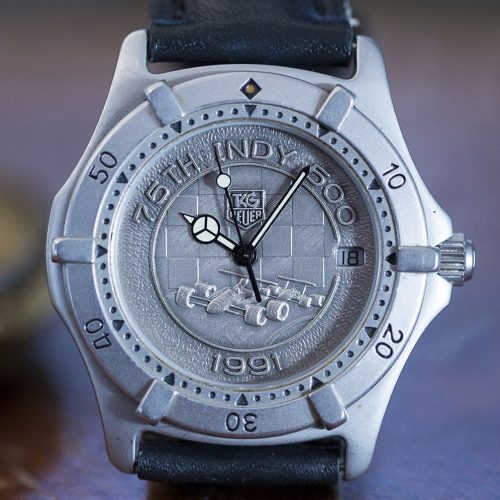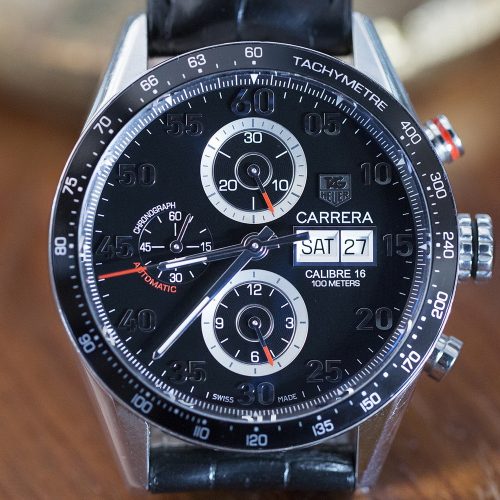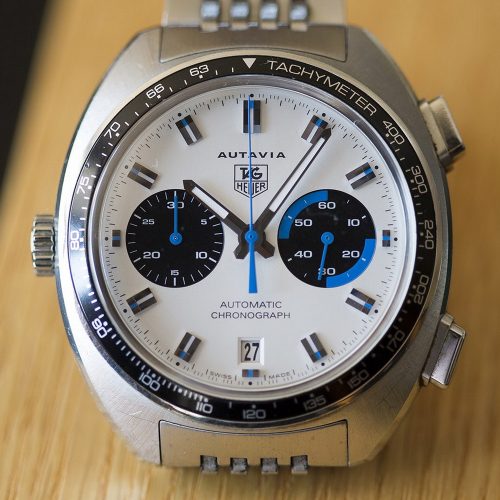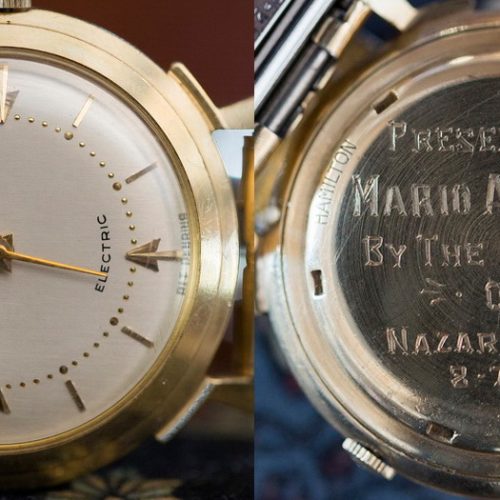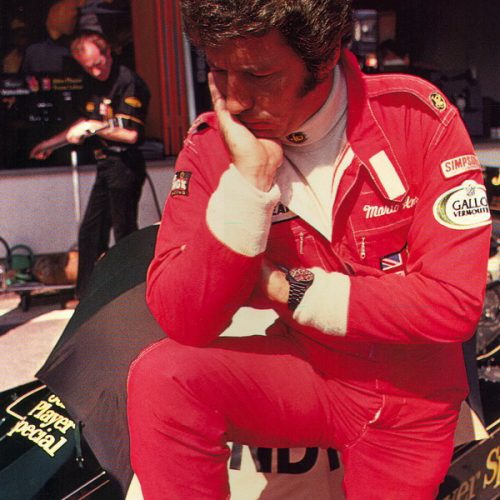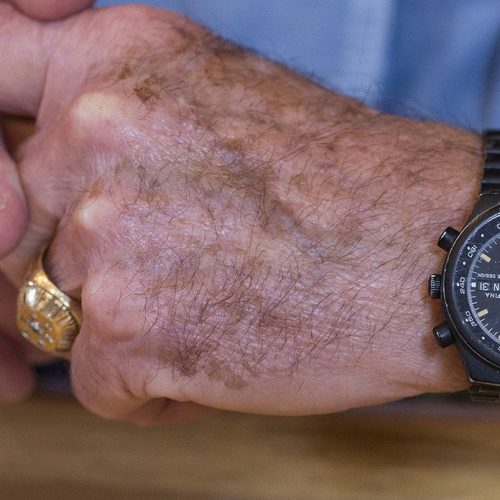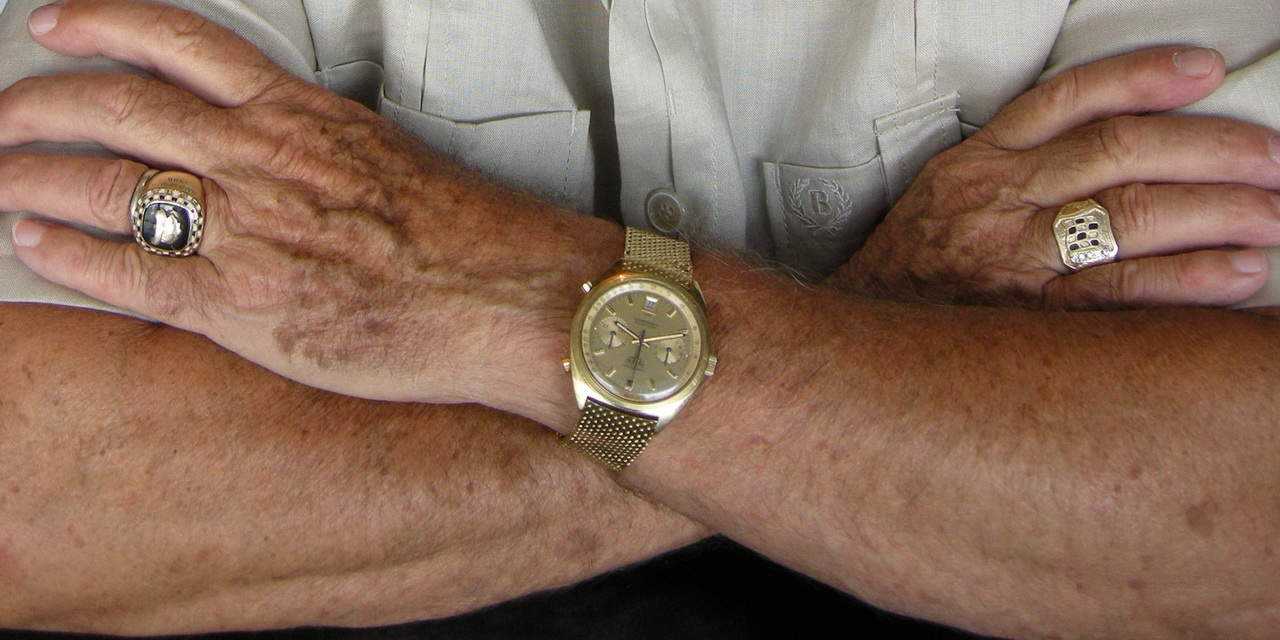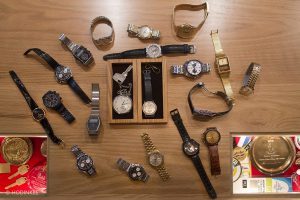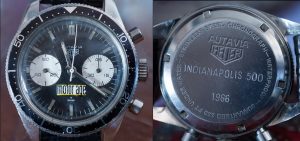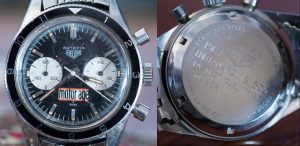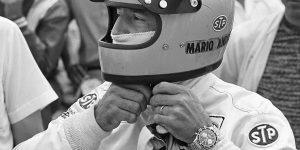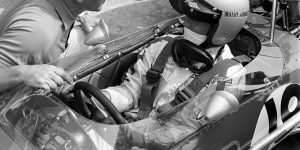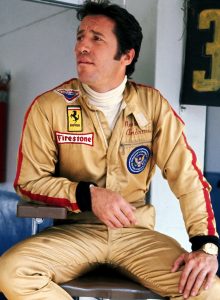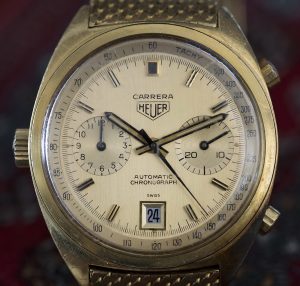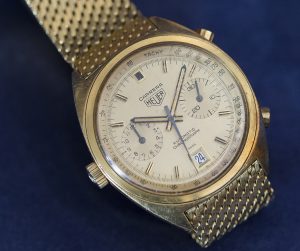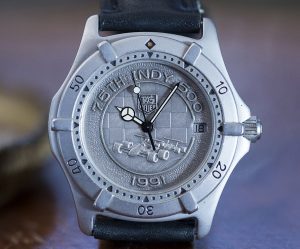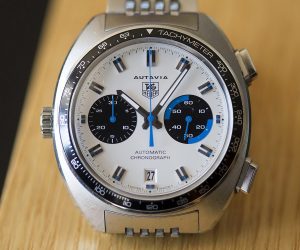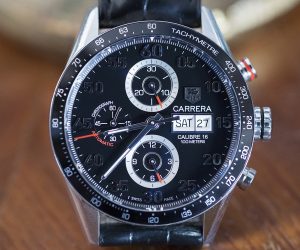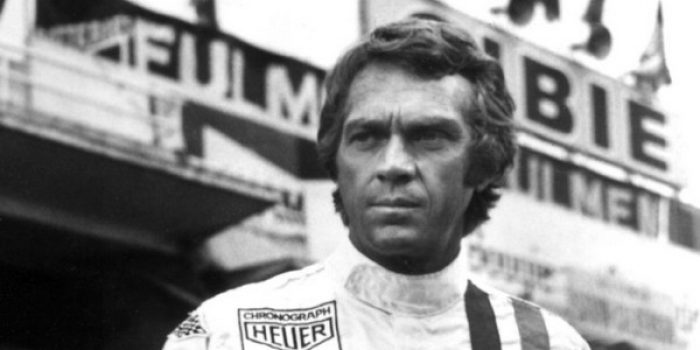If we were to create “Heuer Hero Index” capturing how often each racing champion wore a watch, the variety of Heuer chronographs worn by the racer, and the success that each racer enjoyed on the track, the clear number one Heuer Hero from the 1960s and 70s would be Mario Andretti. Andretti wore watches throughout his career — on the track, in the pits, and during public appearances — and we can count at least 20 different watches in his collection. Of course, Mario Andretti enjoyed great success as a racer, being one of the few racers to win both the Formula One world championship (1978) and the Inidanapolis 500 (1969). Andretti also enjoyed success in American stock car racing (winning the Daytona 500 in 1967) and in endurance / sports car racing (competed at the 24 Hours of Le Mans in four decades).
Mario Andretti is a genuine “watch guy”, wearing chronographs during races and reporting that he might take a selection of several watches to a racing weekend. Andretti was featured in an episode of “Talking Watches” on Hodinkee, and he explained his passion for watches, as well has the fact that he has purchased relatively few of them, but received many watches as gifts, during his racing career.
In this posting, we present the Heuer and TAG Heuer chronographs included in Andretti’s collection.
Mario Andretti’s Heuers
The following table provides an overview of the Heuer chronographs in Mario Andretti’s collection.
| Year | Watch | Occasion |
| 1966 | Heuer Autavia Reference 3646, Motor Age logo on dial (Minutes bezel), on leather strap | awarded for fastest qualifying time in the 1966 Indianapolis 500 |
| 1967 | Heuer Autavia Reference 3646, Motor Age logo on dial (Hour bezel), on stainless steel bracelet | awarded for fastest qualifying time in the 1967 Indianapolis 500 |
| 1972 | Heuer 18 karat gold Carrera, Reference 1158 CH, on bracelet | gift from Jack Heuer, for the Ferrari drivers |
| 1978 | Heuer Manhattan GMT chronograph | unknown |
| 1991 | TAG Heuer Series 2000 (special edition) | awarded to participants in the 1991 Indianapolis 500 |
| 2003 | TAG Heuer Autavia re-issue, in Siffert colors | likely received as TAG Heuer ambassador or in connection with promotional work |
| 2010 | TAG Heuer Carrera Calibre 16 | induction into the Motor Sport Hall of Fame |
Heuer Autavia, Motor Age Logo on Dial (Reference 3646) — 1966 and 1967
Heuer introduced the Autavia chronograph in 1962, with two versions of the watch being available — the Reference 2446 with three registers (12 hour chronograph capacity) and the Reference 3646 with two registers (45 minute chronograph capacity). The early Autavias had screw-back cases and by the mid-1960s, Heuer had switched to the second execution of the screw-back case, with the easy telltales being that the teeth on the bezel are cut diagonally rather than being squared and that the bezel insert is narrower then on the first execution screw-back models.
Mario Andretti was awarded not one, but two, of the Autavia Reference 3646 chronographs, for being fastest in qualifying for the Indianapolis 500, in 1966 and 1967. These watches were awarded by Motor Age, a monthly magazine published for the automobile repair shop trade. (Read more about Motor Age on our “Logos and Specials” page). Across the line of Heuer chronographs, the two register models were preferred for adding logos, as the bottom half of the dial was open space, rather than having the hour recorder.
The Autavia that Andretti won in 1966 has a classic “Minutes” bezel, marked from zero to 60, with lines at the five minute marks, numerals for 10, 30, 30, etc., and dotes for the minutes. While earlier bezels for the Autavia used luminous material for the triangle at the top, by 1966, Heuer was well on its way to reducing the radioactive content of its chronographs, so the radium or tritium has been deleted.
In 1967, Mario Andretti again had the fastest qualifying time for the Indianapolis 500, winning a second Reference 3646 Autavia from Motor Age. This Autavia is identical to the one that Andretti won in 1966, except that the bezel on the 1967 watch is marked for hours. The Motor Age logo also appears to use orange as an accent color, rather then yellow, although it is difficult to be certain whether this is actually different paint or only a difference in the fading over the years.
Although it is difficult to tell “which Autavia is which” when they are viewed on Mario Andretti’s wrist, it is clear that he wore these watches frequently in the 1960s. Here are a couple of photos showing Andretti wearing these watches, back “in the day”.
For additional information about these Autavias, see the OnTheDash Gallery of the “Andretti Autavia
Heuer Carrera, 18 Karat Gold (Reference 1158 CH)
Andretti drove for the Ferrari Formula One team in 1971 and 1972, and under the promotional agreement between Heuer and Scuderia Ferrari, his car carried the Heuer logo and, as a driver, Andretti received an 18 karat gold Carrera chronograph from Jack Heuer.
The model is the Reference 1158 “CH”, indicating that the watch has a champagne dial and matching champagne registers.
It is noteworthy that Andretti’s Carrera is on the 18 karat gold bracelet that was made exclusively for this model. Constructed in “Maglia Milanese” style, this bracelet is comprised of hundreds of small links of gold, assembled into a thick mesh. While the watch case contains 48 grams of gold, this bracelet contains 73 grams, and given the intricacy of the construction, it is not surprising that this bracelet typically cost twice the price of the watch itself.
Just as we see numerous photos of Mario Andretti wearing his Autavias in the 1960s, it appears that Andretti wore his 18 karat gold Carrera frequently in the 1970s, including while he was racing. Considering the relatively soft nature of gold, and the relatively hard nature of the metals of which a race car is built. we can say that only a true “watch guy” would have worn this watch under these circumstances.
Shown below is a favorite photo of Mario Andretti wearing his 18 karat gold Carrera. There has been some debate about the number of these chronographs that Heuer produced; I am confident that this is the only photo showing a man wearing the 18 karat gold Heuer of the Ferrari Formula One driver, the gold ring received for winning the Formula One world championship (on his left hand) and the gold ring for winning the Indianapolis 500 on his right hand.
For additional information about the Reference 1158 Carreras, see our Definitive Guide to the Reference 1158 Carreras.
Heuer Manhattan Chronosplit GMT Chronograph
Heuer introduced its first electronic chronograph in 1975, with the Chronosplit. Soon after that launch, Heuer expanded its line-up of electronic watches with the Manhattan Chronosplit GMT. While the Chronosplit offered two windows with digital displays, in a symmetrical case, the Manhattan employed a digital display for the chronograph functions, with the time-of-day indicated by traditional “analog” hands.
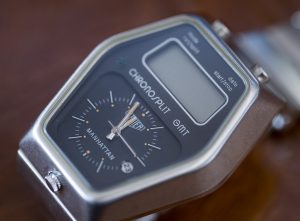
Over the past several years, I have examined thousands of photographs of Mario Andretti, always trying to see and identify the watches that he is wearing. I can report that I have not seen a single photo of Andretti wearing the Manhattan Chronosplit GMT chronograph. Nor can I suggest a decent explanation as to the circumstances under which he might have received this watch.
TAG Heuer Series 2000 — Specially Produced for the 1991 Indianapolis 500
By 1991, TAG Heuer had shifted it focus from the production of chronographs to a comprehensive line-up of dive watches. The 1991 catalog included the 1000 Series, the 1500 Series, the 2000 Series and the 4000 Series, as well as the S/el (Sport / elegance) watches. These lines showed a dizzying variety of models, with TAG Heuer offering men’s and women’s models; the choice of automatic and quartz power; and a choice of sizes, in many models, from small to medium to jumbo.
TAG Heuer referred to the Series 2000 watches as its “flagship timepieces”, and these watches employed what TAG Heuer listed as its six unique functional features — water resistance to 200 meters; a screw-down crown; safety latch on the bracelet; a unidirectional bezel; sapphire crystal; and luminous markings. It is not surprising then that when TAG Heuer produced a special watch to mark the 75th running of the Indianapolis 500, that would only be given to the drivers, the watch was based on the Series 2000.
The watch features a unidirectional bezel, marked in minutes.
TAG Heuer Re-Issue of the Autavia (2003)
Heuer introduced the Autavia chronograph in 1962, and offered approximately 90 different models and executions until production ended in the mid-1980s. In 2003, TAG Heuer re-issued the Autavia, in cushion-shaped case, with a fixed tachymeter. TAG Heuer offered three versions — one had a black dial, with white registers and orange accents; one had a white dial with black registers and blue accents (Heuer’s historic “Siffert” color scheme); and a third version was housed in an 18 karat gold case. The stainless steel models had two registers with a 30-minute chronograph capacity; the rose gold model had three registers with 12-hour chronograph capacity. All these models were powered by ETA 2892 movements paired with Dubois Depraz chronograph modules.
Mario Andretti’s TAG Heuer Autavia is the “Siffert” model, with a white dial, black registers, and blue accents. Around this time, Mario Andretti made some appearances for TAG Heuer, so we can assume that he received this Autavia as part of the compensation for this promotional work.
TAG Heuer Carrera Calibre 16
Mario Andretti was inducted into the Motor Sport Hall of Fame in 2010, and received this TAG Heuer Carrera to mark the occasion. The watch is the Calibre 16 Carrera, Reference CV2A10, a watch that was introduced in 2010. This Carrera features the day / date display and applied Arabic numerals, with a tachymeter bezel.
References
Motor Sport Hall of Fame — Mario Andretti racing biography
Hodinkee — Talking Watches with Mario Andretti
